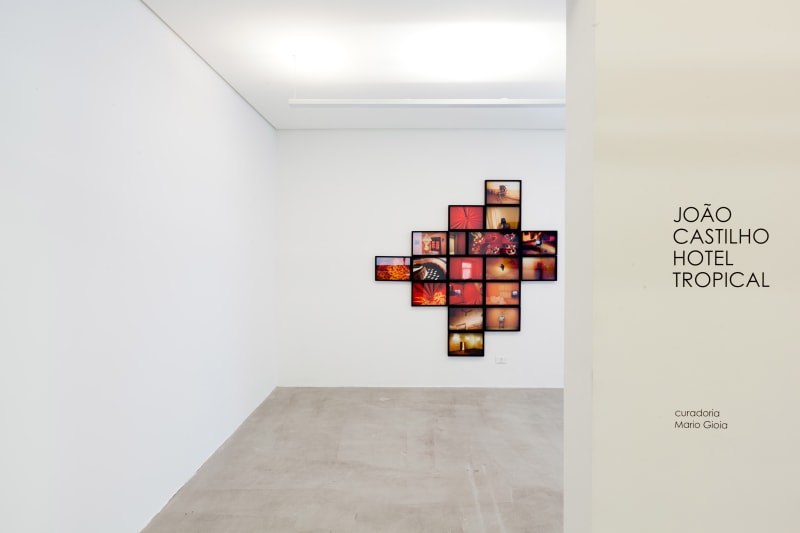Malady of the tropics
Crumbling walls in a backyard. Coat hangers hanging on a support. Fans mounted on a perforated ceiling. A mosquito net with lacework embedded into it. Light from lamps, from the sun bathing a bedroom, from a television set.
Such elements, fragmented in blue, white, green and red, forcefully punctuate the enigmatic, fleeting and dual-edged set of images presented in Hotel Tropical, by the Minas Gerais artist João Castilho. Captured over the course of years in his travels around all the regions of Brazil, except the South, and in Mali, these pictures function as an archive of the various types of spaces of temporary accommodation, where the notion of shelter and comfort are sought, but overlap with the perceived impersonality and coldness of these non-places.
The artist addresses the atmosphere in which the unspoken, the rarefied impressions and open narratives engage the beauty of the photographic installations that constitute his first solo exhibit in São Paulo – admired and known by his peers in the city, for his striking participation in group shows such as Geração 00 – A Nova Fotografia Brasileira, curated by Eder Chiodetto, in 2011, and Paisagem Submersa, in conjunction with Pedro Motta and Pedro David, exhibited in 2008 and published in a book by Cosac Naify.
What Paul Graham said at a photography forum at MoMA in 2010, applies to Hotel Tropical: that part of the contemporary photographic production bears a certain imprecision that, however, reinforces the "accidental" and permeable aspect of this extended field of language. At the same time, the artist attempts to outline some control over this sliding territory, revealed at the frustrated (but no poorer for it) end.
“The problem is that whilst you can discuss what Jeff Wall did in an elaborately staged street tableaux, how do you explain what Garry Winogrand did on a real New York street when he ‘just’ took the picture? Or for that matter what Stephen Shore created with his deadpan image of a crossroads in El Paso? Anyone with an ounce of sensitivity knows they did something there, and something utterly remarkable at that, but... what? How do we articulate this uniquely photographic creative act, and express what it amounts to in terms such that the art world, highly attuned to synthetic creation -the making of something by the artist- can appreciate serious photography that engages with the world as it is?" (1), questions the British artist.
This overlapping area occupied by Castilho is echoed on a global level in the unstable work of various artists, such as the photographs by the German Wim Wenders, in records such as Wall in Paris, Texas (2010), and his compatriot Uta Barth, in series such as Nowhere Near (1999). “It is up to us to determine the significance of a motive, knowing that there must be one, as the artist took the picture and, therefore, highlighted it as significant” (2), remarks the researcher Charlotte Cotton. Silent series by South African Moshekwa Langa, such as Untitled, of 2005-06, also draw parallels with Hotel Tropical. Langa portrays entirely trivial places and objects – a rug, a bucket in a corner, a curtain – but that are impregnated with experiences and request that the narrative be continued by each observer who sees such images.
The bankruptcy of a utopic project of modernity fails to escape Castilho’s lenses, as he elects these somewhat improvised buildings as the featured locus of his comment on the fragile nature of things and living. Here, we can witness dialogue with Dolphin Estate, the 2008 series by Nigerian Otobong Nkanga. A housing estate built hurriedly and delivered incomplete is covered by water tanks, antenna and cables, in a multicolored pile-up, added subsequently by the residents of the African suburb. Nkanga records the voids, the chromatic differences and tone of improvised solutions that dominate the district. It is interesting to note that Nkanga's and Langa's series were shown last year at the 29th São Paulo Biennial, the theme of which was based on art and politics. Therefore, Hotel Tropical and the two cited references can be interpreted in a tone where the experimental cannot be dissociated from the political.
Hotel Tropical creates a particular cartography in the Zip’Up room, installed in such a way as to avoid any regulation of the exhibition space. “There are four acts; the acts are intensities. They vibrate at a certain frequency, which in the case of photography is chromatic. These are the color blocks. For the positioning of the pictures to form the blocks, what I had in mind was the floor plans of the hotels where the photographs were taken. Mental floor plans, as I have never actually held any of them in my hands. These constructions have the ability to develop tentacles that extend up, sideways and down. These are the movements I tried to convey to the blocks”, states the artist.
Castilho signals itineraries to the spectator, who extracts indicative and far-from rigid data to assemble their own narrative. “A piece of a picture, a found picture, a kept picture, a forgotten picture, a hidden picture, a discarded picture, just a picture”, as defined by the artist. Records and constructions that might be affected by a blinding light, but that are overpowered by another kind of light, weaker, but no less vital.
Mario Gioia
(1) TOLEDO, Beatriz (org.). Humble, Silent and Unexplainable. Galeria Virgilio, São Paulo, 2011
(2) COTTON, Charlotte. A Fotografia como Arte Contemporânea. Martins Fontes, São Paulo, 2010, p. 115


